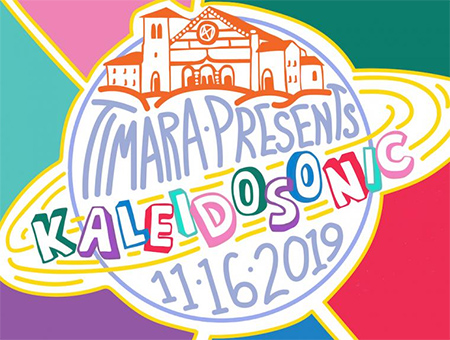by Mike Telin

“Olly Wilson taught the first electronic music course in 1969 and John Clough taught the first computer music class in the spring of 1970,” associate professor of computer music and digital arts Tom Lopez said during an interview. “We thought that 50 years was cause to celebrate.”
Organized by Lopez, the free Kaleidosonic Music Festival will feature nearly 500 musicians performing a variety of styles — gospel, classical, rock and roll, jazz, early music, marching band, serious, funny, and avant-garde.
“Kaleidosonic will be an epic celebration of music at Oberlin. It includes musicians and ensembles from the Conservatory, the College, and the community,” Lopez said. “We’re calling it a festival because it is more than a concert. It will be many hours long and the music will be non-stop — one big, long, sonic collage of ensembles, groups, and individual musicians. People can come and go as they wish and there will be food trucks available from 7:00 until 10:00.”
When visioning the event, Lopez wanted to demonstrate how TIMARA functions as the glue between College and Conservatory departments and the community. “I wanted to put together an event where most of the musical content was drawn from collaborators. There will be about twenty speakers around the audience, who will experience a surround-sound, immersive sonic environment. It is a TIMARA event, but I imagine that a lot of people won’t think of it as an electronic music concert because they’re going to hear a children’s choir, a high school marching band, taiko, and a steel drum ensemble.”
The Kaleidosonic performances are more than a continuous parade of musicians on and off the Finney stage — Lopez has truly curated the event. “One of my favorite pieces is Copland’s Fanfare for the Common Man, so at the beginning I have a brass ensemble and the taiko drums. The ensemble will play the brass part and the taiko will play one of their pieces at the same time, not the drum part from the Copland. This will be an intense, interesting juxtaposition of music.”
Another unlikely pairing will be bagpipes and a marching band. “When the pipes are inside, the band will start playing outside so you’ll hear them from a distance. The band will march into Finney and down the aisles. It’s kind of like Ives.” The bagpipes will also be featured in a new work by TIMARA student Piper Hill.

In his book Red and Hot: The Fate of Jazz in the Soviet Union 1917-1991, S. Frederick Starr writes: “For a 1989 performance at Oberlin College in Ohio [Kuryokhin] assembled jack hammers, four harpists, Javanese gamelan, a gospel choir, and six synthesizers.” Starr served as the president of Oberlin College from 1983 until 1994. (Click here to watch a video of Kuryokhin and his band Pop-Mekhanika curating an event in Liverpool, England.)

L-R: TIMARA faculty and staff Eli Stine, Abby Aresty, Tom Lopez, Aurie Hsu, and Peter Swendsen. Photo by Tanya Rosen-Jones
On Saturday, the intersection between the acoustic and the electronic will be managed by visiting TIMARA professor Eli Stine. Lopez explained that large mixing boards will handle the inputs and the outputs. In between, Stine will have his computer managing the flow of sound. From the center of the space, students armed with laptops will process the sound from the microphones and send it back into the space via the twenty speakers located throughout Finney Chapel. “Eli is command central in terms of the flow of sound to the people doing the live processing.”
Winding down our conversation, Lopez reflected on how much has changed in the world of electronic music in the past 50 years. “It used to be that the only options were reel-to-reel mixed media pieces, or if you were doing something live you were using a MIDI keyboard, and that was fairly limited in its timbre world.”
As a sound artist, Lopez said it has been exciting to be able to play with sound composition and collage on an epic scale. “I have not written a single note — everything that the musicians will play is music that they have brought with them. But I’ve had the luxury of picking the order, and deciding who is overlapping where and with what piece, so I have had a meta level of creative input on this experience.”
Logo photo by Oli Bentley.
Published on ClevelandClassical.com November 12, 2019.
Click here for a printable copy of this article



